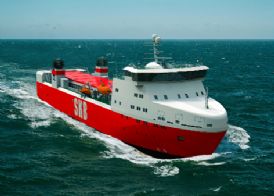User experience the deciding factor when Dutch shipbuilder, Damen, chose IFS
 Bildtext: Set to replace Sigyn. Dutch shipbuilder, Damen, has many important names in its customer directory. One of them is Swedish SKB, which is set to replace the aging spent nuclear fuel transport Sigyn, with the design on the image above. In 2013, the 95.5 meter long vessel will be ready for its ponderous task.
Bildtext: Set to replace Sigyn. Dutch shipbuilder, Damen, has many important names in its customer directory. One of them is Swedish SKB, which is set to replace the aging spent nuclear fuel transport Sigyn, with the design on the image above. In 2013, the 95.5 meter long vessel will be ready for its ponderous task.
Globally based, Dutch shipbuilder, Damen, has successfully gone through an ERP-related ”heart surgery” in order to face the coming 10-15 years of growth, with the help of the Swedish solution IFS Applications 7.5. The vision is to offer complete support of the entire product lifecycle.
Damen builds and services a wide variety of standardized ships spanning the globe, and has now, in line with its expansion plans, bought and implemented the entire IFS Applications 7.5 suite complete with the new IFS Enterprise Explorer user interface. Damen’s previous MRP system was no longer sufficient, as it could not be integrated with the company’s service and logistics processes. And with an increased focus on aftermarket services as one of cornerstones of the shipbuilder’s growth plan, it was necessary to implement a new and significantly broadened business platform that could connect the different areas of business and the processes of the 5 600 man strong, global company.
IFS and SAP in the finals. - We took a very close look at the market before we chose IFS, which was one of two ERP-solutions that covered all of our needs, related to manufacturing, sales and services, says Heino Westdijk, Director of Services at Damen. ?The other finalist was, unsurprisingly enough in these circumstances, SAP. The companies went head to head, and the deciding factor was, according to Westdjik, the user interface, where the IFS Enterprise Explorer interface won out.?
- Our employees are not very IT-savvy. This means that we needed a solution with the highest level of integration and functionality, in addition to this it needs to be so easy to understand that it actually encourages use. This is critical to our expansion plans, says Westdjik.
Search begun in 2009. The process of implementing the system has, according to Wesdjik, been both quick and problem-free – at least at the company’s services department. The search for the perfect ERP/PLM-system started in 2009, and it went live at the services department in October 2010 – nine months later. The system went into production in June 2011.
Needed a new “heart”. – Damen was in need of a new heart, and now that we’ve been on the operating table and gone through the necessary operation, we can grow and develop as we should in the next 10 to 15 years, says Heino Westdijk, using the metaphor to stress the fact that switching to a new ERP-system can be one of the most complicated operations that you can put your business through.
- The planned rollout of the system has so far only been executed in the Netherlands, but will continue for an additional year, since Damen, geographically speaking, is relatively dispersed, with a large number of production facilities and offices around the world. And the plan, going forward, is to stick with IFS standard, with a minimum amount of customization. “The rollout has to be easy on all of our different sites.”?
Damen is a part of an IFS Advisory Council, which acts as a platform for exchanging knowledge and experience, it also gives its members the opportunity to have a say in the future development path of the ERP-system. Heino Westdijk sees the company’s participation as a great advantage, and also points out that Damen is actively working to make changes to the standard version of IFS’s solution.?
– The shipbuilding industry hasn’t quite caught up with aerospace and automotive in terms of adopting IT-solutions, and there’s certainly a lot of room for improvement. But IFS are good at listening to and working with the customers and the organizations that represent their needs, says Heino Westdijk. He thinks that standard modules, specially built to support the needs of the shipbuilding industry, are the way forward. And it might not be far from the truth. With the solution in hand, IFS has successively gained a number of companies within Damen’s industry segment, like SMIT and Heerema Fabrication.
Aftermarket opportunities. With the new heart in place, the company can now go ahead and begin an organization-wide standardization of processes, systems and data. An area where the company really has been picking up steam is aftermarket sales, which in time, should amount to almost half of Damen’s total revenue. The company has been sailing against the wind since 1927, when they, unlike their competitors chose to focus on standard platforms, instead of customization. But when it comes to the services and support area, the company hasn’t been quite as quick on its feet, Westdijk admits.
- It took 35 years before we actually started seeing the aftermarket as a business opportunity. And it was five years ago since we started offering the services, which customers by and large demand these days.
- Service is an unnecessary headache for many of our customers, and by taking this part on ourselves, we allow our customers to focus on the things that they do best.
And the effort of the last five years has paid off - Damen has among other things, already taken over a few private-public partnerships. This means taking over the service and support obligations that up until then were handled by the customers or their subcontractors. In addition to this, the company has been working extensively on improving their leasing package, and according to Heino Westdijk, it will without doubt be a very popular option in the near future.
- Taking care of the service aspect has brought us closer to our customers, and this close relationship has turned into one of our most important competitive advantages, says Westdijk.
Aiming for 40 percent. The service branch of Damen currently generates about 23 percent of the company’s total revenue, and in this regard, Heino Westdijk sees a lot of low hanging fruit, which would propel them to their goal of 40 percent. In its current state Damen puts out between 150 and 180 ships annually, which results in a large fleet in need of service. In addition to this it’s important to remember that ships tend to stay in use of a long time, and that the company during the last 40 years has produced over 5000 ships of varying sizes – from small boats at around 8 meters, to large advanced frigates, of which, most will be subject to the new service agreement.
The perfect reference. It’s not uncommon for a ship contain over 100 000 components. And while the service processes might be made easier by the use of standard platforms, there’s still a need for a cohesive PLM system to manage the massive data flow and to make sure that the right part is at the right place, at the right time. And the success story of Damen lends IFS a lot of credibility in this respect, by offering an example of what a customer can do with a single integrated PLM system, managing all of the product development processes from cradle to grave. Because Damen’s new system is probably more PLM than it is ERP. One of the things it is tasked with is to help and support the development of the standardization process, which also includes advanced modular design of, among other things, port facilities. And it’s no small task – the ship catalogue alone contains around 200 different designs that can and will be built for storage.
350 service organizations. All of this combined with the ramp up on the service-side – which in time will provide complete support over the entire product lifecycle, with service and management of all the components built into the ship’s construction. This certainly lends the implementation a certain air of PLM. With the Swedish solution, relevant information from the logistics chain, service technicians and the purchasing department is collected, managed and made available to the right people involved in the processes, this, in turn, leads to an optimization of both design and logistics.
- But IFS can’t do this alone. The only way we can optimize our design and logistics processes is by having competent people in the service department to react to and report the requested data, says Heino Westdijk, always emphasizing the importance of the people involved.
 Flyt för Aras PLM: - De senaste årens vinnare när det gäller nya användare
Flyt för Aras PLM: - De senaste årens vinnare när det gäller nya användare Flyt för Aras PLM: - De senaste årens vinnare när det gäller nya användare
Flyt för Aras PLM: - De senaste årens vinnare när det gäller nya användare ”Great ERP, worse PLM” – What SAP PLM needs to sharpen its competitive edge
”Great ERP, worse PLM” – What SAP PLM needs to sharpen its competitive edge PLM Spending: A period of “Digestion” after two years of explosive growth
PLM Spending: A period of “Digestion” after two years of explosive growth The Market for PLM Services: Why Accenture thinks they can rattle IBM
The Market for PLM Services: Why Accenture thinks they can rattle IBM TV-report: The Internet of Things – The secret to what PLM and ERP can do in the smart revolution
TV-report: The Internet of Things – The secret to what PLM and ERP can do in the smart revolution Not ”a load of crap” anymore: ”PLM 360 is way ahead of plan”, says Autodesk’s Carl Bass
Not ”a load of crap” anymore: ”PLM 360 is way ahead of plan”, says Autodesk’s Carl Bass "Demolish the silos in PLM": Why Dassaults Bernard Charles believes in the 3D Experience
"Demolish the silos in PLM": Why Dassaults Bernard Charles believes in the 3D Experience The Next Big Boom in PLM and ERP and the Battle Over mBOM Ownership
The Next Big Boom in PLM and ERP and the Battle Over mBOM Ownership From the graveyard of ERP to the world’s largest start-up: Infor TV Report
From the graveyard of ERP to the world’s largest start-up: Infor TV Report What Happened to Volvo engineering and PLM under Chinese ownership?
What Happened to Volvo engineering and PLM under Chinese ownership? Will GE and PTC’s joint venture create a ”PLM and manufacturing advantage”?
Will GE and PTC’s joint venture create a ”PLM and manufacturing advantage”? Inside Daimler Mercedes Switch from Dassault Systèmes to Siemens PLM and NX
Inside Daimler Mercedes Switch from Dassault Systèmes to Siemens PLM and NX Truck Maker’s PLM Model a Focus in Volkswagen’s War Over Ownership
Truck Maker’s PLM Model a Focus in Volkswagen’s War Over Ownership The Role of 3D Printing in Manufacturing and PLM – TV Report
The Role of 3D Printing in Manufacturing and PLM – TV Report The Third Platform – A Quantum Leap for PLM and ERP
The Third Platform – A Quantum Leap for PLM and ERP  SolidWorks Mechanical Conceptual: Late and Great, but too Expensive? – TV Report
SolidWorks Mechanical Conceptual: Late and Great, but too Expensive? – TV Report Big Data – Big Problem? – TV Report
Big Data – Big Problem? – TV Report Applauds to the European Parliament’s call to modernise EU public works projects with BIM technology
Applauds to the European Parliament’s call to modernise EU public works projects with BIM technology Siemens, Tesis PLMware and Industry 4.0
Siemens, Tesis PLMware and Industry 4.0 Why PTC acquired ThingWorx and how M2M will change everything
Why PTC acquired ThingWorx and how M2M will change everything Autodesk’s CEO, Carl Bass: We want to change the way people work – TV Report
Autodesk’s CEO, Carl Bass: We want to change the way people work – TV Report How MOBILITY transforms Product Development, Manufacturing and Service – TV Report
How MOBILITY transforms Product Development, Manufacturing and Service – TV Report Can PLM Systems Manage Highly Complex Products? – TV Report
Can PLM Systems Manage Highly Complex Products? – TV Report Dassault’s 3DEXPERIENCE Platform – TV Report
Dassault’s 3DEXPERIENCE Platform – TV Report PLM Systems Cleared for Take Off at Airbus
PLM Systems Cleared for Take Off at Airbus FRONTRUNNERS Takes a Look Inside Volvo’s Construction Equipment
FRONTRUNNERS Takes a Look Inside Volvo’s Construction Equipment Battle of the Visions part 3: PTC breaks new ground in the PLM landscape - claims CEO Jim Heppelmann
Battle of the Visions part 3: PTC breaks new ground in the PLM landscape - claims CEO Jim Heppelmann User experience the deciding factor when Dutch shipbuilder, Damen, chose IFS
User experience the deciding factor when Dutch shipbuilder, Damen, chose IFS PTC’s Windchill 10.0 – will 100 million in R&D take PLM to the next level?
PTC’s Windchill 10.0 – will 100 million in R&D take PLM to the next level? The French Connection ...more possibilities than problems, when SolidWorks is “dassaultified”?
The French Connection ...more possibilities than problems, when SolidWorks is “dassaultified”? Management swap at SolidWorks - Jeff Ray Steps down as CEO, Bertrand Sicot takes over
Management swap at SolidWorks - Jeff Ray Steps down as CEO, Bertrand Sicot takes over SolidWorks’ Jeff Ray confirms in an interview transition to Dassault’s V6 platform
SolidWorks’ Jeff Ray confirms in an interview transition to Dassault’s V6 platform 25/11/2011
BIZ
25/11/2011
BIZ
 VERKSTADSFORUM.SE:S TELEGRAMREDAKTION
VERKSTADSFORUM.SE:S TELEGRAMREDAKTION



















